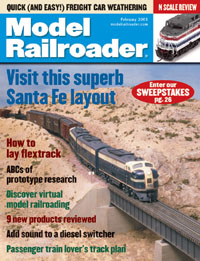
Reproduced from the February 2003 Issue of Model Railroader.
Copyright 2003 Kalmbach Publishing Co. Used with permission of Model Railroader Magazine
What does the National Model Railroad Association have to do with workin' on my railroad? The short answer is: standards. But let me give you a little background first.
Belonging to the NMRA has many benefits, which are described on its Web site at www.nmra.org. I've always considered the friendships made at NMRA meets a valuable asset. But recently I've discovered the importance of standards set by the organization and what they mean to the hobby.
In 1935 the National Model Railroad Association was founded in Milwaukee, and it has become the largest organization in the world devoted to the hobby of model railroading. Before the 1930s, there were no standards pertaining to model railroad equipment. One manufacturer's equipment would not necessarily work with another's, and many modelers set their own standards from their designs and ideas. It became more and more difficult, if not impossible, to take equipment from one model railroad and expect it to run on another.
So a group of model railroaders, manufacturers, and publishers decided it was time to bring order to the hobby. Standards were developed to guarantee that equipment could be interchanged between individual model railroads. These standards ensured cars and locomotives purchased from one manufacturer could run on the track of another manufacturer. Many of the original standards still remain in effect today, virtually unchanged.
I never fully understood how important NMRA standards were to the hobby until I was recently researching Digital Command Control (DCC).
During the mid-1990s the NMRA began the process required to introduce a standard for DCC. The standard covers the digital signal traveling from the command station to the decoders controlling locomotives and other accessories such as switch machines. All manufacturers have to abide by this signal standard in order to receive NMRA conformance approval. Electronics required for DCC quickly got cheaper and DCC became more popular. Had it not been for the efforts of the NMRA and its volunteers, the advancements made in DCC would not have happened nearly as fast.
So what does belonging to the NMRA do for me and you? It lets us purchase products from manufacturers without worrying about compatibility.
The NMRA has much to offer the individual modeler besides standards, such as a library providing thousands of books, magazines, photos, and slides. There are local meets, plus regional and national conventions to attend throughout the year, where you can get together with fellow modelers and enjoy clinics about every aspect of our hobby.
So the next time you're running that new locomotive or installing replacement wheelsets on a boxcar, remember how important the NMRA is to you being able to work on the railroad.
A.) The most common use of the standards gauge is to check that your track is the correct width. Remember the gauge is made of metal, so be sure you don't have any power going to the rails or you may cause a short.
B.) Standards established by the NMRA keep modelers from being stopped in their tracks. Lionel Strang uses his HO scale NMRA standards gauge to check the clearance of a loading dock.
C.) Digital Command Control has become quite popular with modelers, thanks in no small part to standards established early on by the NMRA, which allow a decoder from one manufacturer to be used with a command station from another.